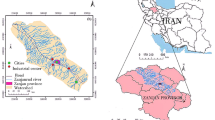Abstract
Several methods have been developed for vulnerability mapping in karstic areas. These methods need additional validation by field experiments. Several tests have been carried out in the Swiss Jura with natural and artificial tracers. The protective role of some intrinsic properties of the system, such as glacial deposits covering karst, epikarst storage and system dilution effect, have been clearly demonstrated. Use of three tracers in parallel showed the reactivity of the epikarst: all tracers arrived at the same time, but their relative concentration stayed clearly different. A classification of contamination scenarios into four classes is proposed. It is shown that the relevance of some intrinsic properties depends on the considered scenario class. The hydrodynamic state of the aquifer influences greatly flow velocities and can strongly modify contaminant concentrations at the output of the system. The spatial repartition (point vs diffuse) and the quantity of contaminant entering the system will also influence the output response. Hence, results from tracing experiments cannot be used straightforward for obtaining a representative value of flow velocity, dispersion or recovery rate.







Similar content being viewed by others
References
Blant D, Puech V (2001) La grotte de Vers chez le Brandt et cavités alentours. Cavernes 1:7–11
Bottrell SH, Atkinson TC (1992) Tracer study of flow and storage in the unsaturated zone of a karstic limestone aquifer. In: Werner H (ed) Tracer hydrology. Balkema, Rotterdam, pp 207–211
Brouyère S, Jeannin P-Y, Dassargues A, Goldscheider N, Popescu I-C, Sauter M, Vadillo I, Zwahlen F (2001) Evaluation and validation of vulnerability concepts using a physically based approach. In: Zwahlen F, Mudry J (eds) 7th Conference on Limestone Hydrology and Fissured Media. University of Franche-Comté, memoirs no 13, Besançon, pp 67–72
Daly D, Dassargues A, Drew D, Dunne S, Goldscheider N, Neale S, Popescu I-C, Zwahlen F (2002) Main concepts of the ‘European approach’ to karst-groundwater-vulnerability assessment and mapping. Hydrogeol J 10:340–345
Doerfliger N, Jeannin P-Y, Zwahlen F (1999) Water vulnerability assessment in karst environments: a new method of defining protection areas using a multi-attribute approach and GIS tools (EPIK method). Environ Geol 39(2):165–176
Goldscheider N, Hötzl H, Fries W, Jordan P (2001) Validation of a vulnerability map (EPIK) with tracer tests. In: Zwahlen F, Mudry J (eds) 7th Conference on Limestone Hydrology and Fissured Media. Univ. of Franche-Comté, memoirs no 13, Besançon, pp 167–170
Jeannin P-Y (1996) Structure et comportement hydraulique des aquifères karstiques. PhD Thesis, Neuchâtel
Jeannin P-Y, Cornaton F, Zwahlen F, Perrochet P (2001) VULK: a tool for intrinsic vulnerability assessment and validation. In: Zwahlen F, Mudry J (eds) 7th Conference on Limestone Hydrology and Fissured Media. University of Franche-Comté, memoir no 13, Besançon, pp 185–188
Perrin J, Jeannin P-Y, Zwahlen F (2003) Implications of the spatial variability of the infiltration water chemistry for the investigation of a karst aquifer. Hydrogeol J (in press)
Schnegg P-A, Doerfliger N (1997) An inexpensive flow-through field fluorimeter. La Chaux-de-Fonds (ed) Proceedings of the 12th International Congress of Speleology, vol 2. Swiss Speleological Society, pp 47–50
Smart PL, Friederich H (1986) Water movement and storage in the unsaturated zone of a maturely karstified carbonate aquifer, Mendip Hills, England. Proceedings of a Conference on Environmental Problems of Karst Terrains and their Solutions. Dept National Water Well Association, Ohio, pp 59–87
Teutsch G, Sauter M (1998) Distributed parameter modelling approaches in karst-hydrological investigations. Bull Hydrogéol 16:99–109
Acknowledgements
The authors are indebted to R. Le Fanic, V. Puech, F.Bourret and T. Ettlin for fieldwork and analyses in the lab; and also thank the L’Abbaye local authorities for providing the opportunity to study in detail the Lionne karstic spring. R. Hirata made useful comments, which improved the readability of the paper.
Author information
Authors and Affiliations
Corresponding author
Rights and permissions
About this article
Cite this article
Perrin, J., Pochon, A., Jeannin, PY. et al. Vulnerability assessment in karstic areas: validation by field experiments. Env Geol 46, 237–245 (2004). https://doi.org/10.1007/s00254-004-0986-3
Received:
Accepted:
Published:
Issue Date:
DOI: https://doi.org/10.1007/s00254-004-0986-3




